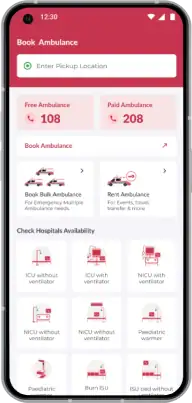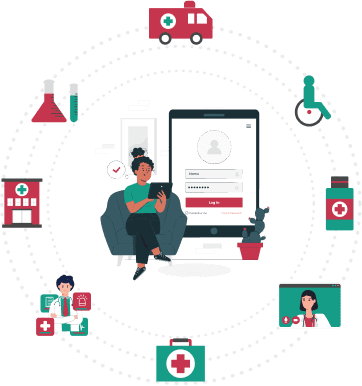Rural areas are often characterized by their serene landscapes and tight-knit communities. However, they also come with their own set of challenges, particularly when it comes to accessing timely medical assistance. In this article, we'll delve into the unique challenges faced by ambulance services in rural regions and explore innovative solutions that strive to bridge the gap in healthcare accessibility.
Challenges Faced by Ambulance Services in Rural Areas
Geographical Distance and Terrain:
In faraway countryside places, the land can be really big and hard to travel on. This can cause problems for ambulances trying to get to sick people fast, especially when the weather is bad. The roads might be tough to drive on, and it takes longer to reach someone who needs help. When the weather is not good, like during storms, it's even trickier for ambulances to move around. This can be worrisome because people might need quick medical attention, but it takes a while for the ambulance to reach them. So, it's important to think of ways to solve these problems and help ambulances reach folks in need, even in far-off places.
Limited Infrastructure:
In rural places, the roads and things we use to travel might not be in good condition. This can cause ambulances to take more time to reach someone who needs help. Sometimes, the places are so hard to reach that ambulances can't get there at all. This can make it tough for people in those areas to get medical assistance quickly. It's important to find solutions to this problem so that everyone, no matter where they live, can get the help they need when they're sick or hurt.
Lack of Healthcare Facilities:
In rural places, there aren't many hospitals or clinics. This means that if someone gets sick or hurt, they might have to travel a long way to find the right help. People in these areas might need to go a big distance to get the care they need. This can be hard because they're not close to doctors or medical equipment. It's important to think about ways to bring medical help closer to these areas, so people don't have to go so far when they're not feeling well. This is a challenge we need to solve so that everyone can get the right care, no matter where they live.
Shortage of Medical Personnel:
In rural regions, there aren't always enough doctors and nurses, especially the ones who know how to help in emergencies. This can make it hard for ambulances to have enough trained people to help sick or hurt folks. These special helpers are called EMTs. Because there aren't many of them in rural areas, it might take longer for an ambulance to come and give medical help. It's important to figure out how to get more trained people in these areas so that everyone can get help when they need it.
Communication Challenges:
In remote areas, like deep in the countryside, it's sometimes hard for phones and radios to work well. This can make it tough for ambulance teams to talk to hospitals and doctors. When ambulances need help or advice, the bad communication can slow things down. It's important to find ways to make communication better, so that everyone can work together and help sick or hurt people quickly. This way, even in far-off areas, the ambulance teams can get the right guidance and care to the people who need it the most.
Solutions for Providing Timely Medical Assistance in Rural Areas
Community-Integrated Services:
Ambulance services can work together with the people in the area to teach them simple first aid, CPR and what to do right away when there's an emergency. This helps so that if something bad happens, the community members can help while waiting for the ambulance to arrive. It's like having extra helpers who know what to do until the doctors come. This teamwork between ambulance services and local folks ensures that quick and helpful care is given, making a big difference for someone who's hurt or sick. It's all about helping each other and being prepared for the unexpected.
Mobile Clinics and Telemedicine:
Setting up medical clinics that can move or using special computer programs to talk to doctors far away can help. These doctors can look at patients through video calls and tell the people on the scene what to do. This way, even when doctors aren't nearby, they can still help and make sure everyone gets the right care. It's like having a faraway doctor right there to guide and help in emergencies. This is a smart way to bring medical help closer, even when it's hard to reach certain places.
Multi-Functional Ambulances:
Equipping ambulances with advanced medical equipment and personnel trained in diverse medical situations allows them to provide preliminary treatments, stabilize patients and offer diagnostic services during transit.
Air Ambulances:
Sometimes, in places where the land is difficult to travel through or where people live far away, special helicopters called air ambulances can help. These helicopters can fly over mountains, forests and other tricky places, which makes getting sick or hurt much faster. They can also help when someone is very far from a hospital. Air ambulances are like superheroes in the sky, bringing fast help to people who need it the most.
Also Read: Understanding Air Ambulance Cost & Factors Affecting it
Advanced Routing and Navigation Systems:
Using smart navigation technology can help ambulances find the fastest paths and go around things blocking the way. This makes them reach people who need help much quicker. It's like having a smart guide that helps ambulances get to where they're needed faster. This technology also helps them avoid things like traffic or bad roads. By using this smart guide, ambulance response times can become much better and they can help people in trouble sooner.
Collaboration with Local Resources:
Partnering with local fire departments, police stations and community organizations can enhance the efficiency of ambulance services in rural areas, providing a network of support.
MedCab: Extending Ambulance Services to Rural Areas
In the effort to bridge the gap in healthcare accessibility, MedCab’s ambulance services has emerged as a trailblazer. We understand that every life is valuable, regardless of location and are committed to providing timely medical assistance to even the most remote areas.
Our approach encompasses innovative solutions tailored to the challenges of rural settings:
Well-Equipped Fleet: Our ambulance fleet is equipped with state-of-the-art medical equipment, ensuring comprehensive care during transit.
Skilled Medical Personnel: Our paramedics undergo rigorous training to handle diverse medical scenarios, ensuring quality care from the moment they reach the patient.
Air Ambulance Services: For areas with challenging terrain, we offer air ambulance services that swiftly transport patients to the nearest medical facility, minimizing transit time.
At MedCab, we understand that access to quality healthcare is a right, not a privilege. Our commitment to extending our services to rural areas stems from our belief that timely medical assistance can make a life-saving difference. With MedCab, rural communities can rest assured that help is just a call away, no matter where they are located.






